
This elusive ailment, characterized by frequent, painful urination without an apparent cause, perplexes even the most seasoned pet owners. But fear not, as unraveling the mystery of FIC is not as daunting as it seems.
With the right knowledge on management and treatment strategies, you can take the necessary steps to ensure your feline friend’s comfort and happiness.
Key Takeaways about Feline Idiopathic Cystitis
- Feline Idiopathic Cystitis (FIC) management requires a mult-imodal approach including diet changes, stress reduction, and, perhaps, pharmacological intervention
- Increasing water intake and providing a stress-free environment are key to preventing FIC flare-ups
- No single treatment exists for FIC; personalized care plans developed in consultation with a veterinarian are essential
Understanding Feline Cystitis

Middle aged cats are most likely to be diagnosed with FIC
Feline Idiopathic Cystitis (FIC) emerges as a perplexing condition within the realm of feline lower urinary tract diseases (FLUTD), setting itself apart with its idiopathic nature. This condition underscores a significant health concern, characterized by inflammation of the bladder without a discernible cause. Unlike other FLUTD forms triggered by identifiable factors such as urinary tract infections, bladder stones, or urethral plugs, FIC presents a diagnostic challenge due to its elusive etiology.
The term “idiopathic” in FIC indicates the absence of a known cause, despite exhaustive diagnostic efforts. This condition bears a striking resemblance to Interstitial Cystitis in humans, a chronic condition where bladder pressure is frequent along with bladder pain, and pelvic pain. The similarity lies in the chronic, painful, and often fluctuating course of the disease, alongside a lack of identifiable infection or other clear causative factors. This parallel not only highlights the complexity of FIC but also paves the way for a comparative understanding that might benefit both veterinary and human medicine.
FIC predominantly affects young to middle-aged cats, casting a shadow over their health and well-being. A noteworthy observation is the condition’s predilection for male cats, which is particularly concerning due to the potential for life-threatening urinary obstructions. The disease’s prevalence underscores a significant health issue within the feline community, affecting a considerable number of cats across various breeds and environments.
The impact of FIC extends beyond the physical symptoms it induces. The condition often leads to significant distress for both the affected felines and their caretakers, given its chronic nature and the challenge it poses in management and treatment. The inability to pinpoint a cause complicates therapeutic strategies, making FIC a focal point of veterinary research and clinical attention.
Symptoms of Feline Cystitis
Feline Idiopathic Cystitis (FIC) manifests through a series of clinical signs that are distressing for both the cat and the owner. Understanding these signs is crucial for early detection and management of this complex condition.
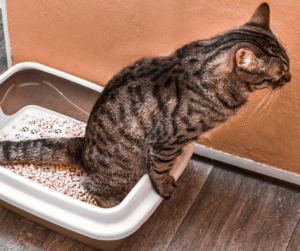
Cat having a difficult time peeing
Painful and Difficult Urination
One of the most noticeable signs of FIC is dysuria where cats experience pain and difficulty while urinating. You will notice prolonged squatting in the litter box, discomfort, or vocalization due to the pain. The act of urination turns into a laborious process, often resulting in very little urine output.
Presence of Blood in Urine
Hematuria, or blood in the urine, is another hallmark symptom of FIC. The presence of blood can vary from overtly bloody urine to a faint discoloration. This sign is particularly alarming as it directly indicates inflammation or irritation within the urinary tract.
Increased Frequency of Urination
Cats with FIC tend to visit the litter box more frequently than normal. This increased frequency, known as pollakiuria, often results in the production of small amounts of urine each time. Your kitty may want to urinate more frequently due to the discomfort and accompanying inflammation.
Urinating Outside the Litter Box
Another significant symptom associated with FIC is periuria, where affected cats urinate in unusual or inappropriate locations. i.e. NOT in the litter box! This change in habit is not a mere act of defiance or behavioral issue but a sign of distress and discomfort.
Overgrooming and Licking of Genital Area

Cat overgrooming is another red flag for FIC
Cats suffering from FIC may excessively lick their genital area due to irritation. This overgrooming can lead to hair loss and skin irritation in the perineal region, further indicating the discomfort caused by the condition.
Straining to Urinate with Little to No Output
Particularly in male cats, stranguria, or the straining to urinate with little to no urine output, can signify a partial or complete urethral blockage. This is a critical emergency requiring immediate veterinary attention to prevent life-threatening complications.
These symptoms not only reflect the pain and discomfort experienced by cats suffering from FIC but also underscore the necessity for prompt veterinary consultation. Early recognition and intervention can significantly enhance the quality of life for affected felines.
Causes and Risk Factors of Feline Idiopathic Cystitis
While the precise cause of FIC eludes veterinary science, research is finding a constellation of risk factors and underlying mechanisms. Moreover, even though the following factors do not directly cause FIC, they are strongly associated with its occurrence:
Stress
A paramount factor, stress significantly influences the onset and exacerbation of FIC. Cats experiencing changes in their environment, routine, or social dynamics are particularly vulnerable. Stressful events can trigger episodes of FIC, suggesting a profound link between the condition and the cat’s emotional state.
Indoor Lifestyle
Cats confined indoors may face limitations in their natural behaviors such as hunting and exploring. This restriction can lead to stress and boredom, contributing to the risk of developing FIC.
Multi-cat Households
Inter-cat aggression and competition for resources in homes with multiple cats are sometimes a source of significant stress, increasing the likelihood of FIC.
Diet

Could a dry food diet contribute to FIC?
A diet primarily consisting of dry food is often observed in FIC cases. Such diets may lead to decreased water intake and more concentrated urine, which can irritate the bladder lining and exacerbate symptoms.
Certain physiological abnormalities are found in cats with FIC, offering insight into the disease’s internal mechanisms.
For one, cats with FIC often have bladders with compromised mucosal lining, which is primarily composed of glycosaminoglycans (GAGs). This allows irritants in the urine to directly irritate and inflame the bladder’s sensitive lining.
The nervous system also plays a crucial role in the pathology of FIC. Nerve stimulation, whether by local bladder irritation or stress-induced signals from the brain, can exacerbate bladder inflammation.
Intriguingly, cats with FIC also exhibit atypical responses to stress. While a healthy stress response involves the secretion of certain hormones to manage and mitigate stress, cats with FIC demonstrate abnormal hormonal responses, which may impair their ability to cope with stress adequately.
Understanding these risk factors and physiological nuances is crucial for cat owners and veterinarians alike after a cat receives a diagnosis of FIC.
Diagnosing Feline Idiopathic Cystitis
The diagnosis of Feline Idiopathic Cystitis begins with a detailed clinical examination and a comprehensive review of the cat’s medical history. During this initial consultation, veterinarians listen carefully to the pet owner’s observations of symptoms such as difficulty urinating, frequent attempts to urinate, and blood in the urine. This provides invaluable clues that guide which lab procedures will be undertaken to pursue an accurate diagnosis.
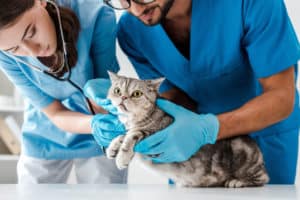
Vet checking for FIC
Urinalysis stands as the cornerstone of the diagnostic regimen. This test provides a wealth of information, from identifying the presence of blood and inflammatory cells in the urine to assessing its concentration and detecting microscopic crystals.
A sterile urine sample may also be cultured to rule out urinary tract infections (UTIs). UTIs present with similar clinical signs to FIC but are caused by bacterial infections, which FIC, being sterile, lacks.
Your vet may also suggest imaging like X-rays to visualize the bladder and urethra. These techniques are instrumental in excluding things like bladder stones or tumors that can mimic FIC.
Ultrasound provides another non-invasive way to examine the bladder wall’s thickness and the bladder’s contents. In FIC, the bladder wall may be thickened due to chronic inflammation, and ultrasound can help assess this aspect.
After other conditions are ruled out through these meticulous tests, a diagnosis of Feline Idiopathic Cystitis is reached by exclusion. It’s a diagnosis that comes after careful elimination of all other potential causes of the cat’s urinary distress, ensuring that the treatment plan is as accurate and effective as possible.
Managing and Treating Feline Idiopathic Cystitis
The cornerstone of managing FIC lies in a multi-modal treatment strategy, emphasizing dietary changes, environmental modifications, and, where necessary, pharmacological intervention.
Dietary Modifications
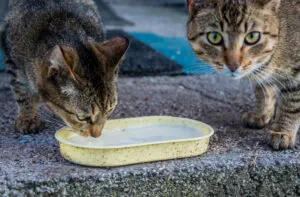
Increase your cat’s water intake
A critical aspect of managing FIC involves increasing water intake and producing more dilute urine. Diluting urine reduces its irritant effect on the bladder’s lining, potentially minimizing inflammation and discomfort. Transitioning to a wet diet from dry food diet is advisable, as wet diets naturally increase a cat’s water consumption. Encouraging water consumption through multiple water sources, flavoring water with chicken broth, and employing water fountains can also promote hydration. Some veterinary therapeutic diets are also formulated specifically for urinary health, incorporating polyunsaturated fatty acids to combat inflammation.
Environmental Stress Reduction
Given the significant role stress plays in triggering episodes of FIC, creating a stress-reduced environment is paramount. Cats thrive in environments where they feel safe and have control over their personal space. Providing multiple, separated key resources—such as food, water, and litter boxes—reduces competition and stress, particularly in multi-cat households. Enriching the cat’s environment with hiding spots, climbing opportunities, and interactive toys can help in mitigating stress. Strategies such as maintaining a consistent daily routine and slowly introducing any changes are crucial in minimizing stress-related triggers of FIC.
Furthermore, ensuring each cat has a ‘safe space,’ preferably elevated, where they can retreat undisturbed, is essential. The use of synthetic feline facial pheromones can also aid in creating a calming environment.
Pharmacological Interventions
Pharmacological interventions, while not universally effective, can offer additional relief and prevention for recurrent cases. Pain management is a critical component, with options including low-dose opioids for acute pain relief. Given the suspected link between stress and FIC, anti-anxiety medications like SSRIs and TCAs are possible prescriptions.
Glycosaminoglycans (GAGs) whihci is a naturally occurring substance that helps protect the bladder lining, is on the table as a therapeutic option. While studies have yet to conclusively demonstrate their effectiveness in treating FIC, anecdotal evidence suggests cats may benefit from it. However, the decision to use these medications should involve consultation with a veterinarian.
A Breakthrough in Treating Feline Idiopathic Cystitits
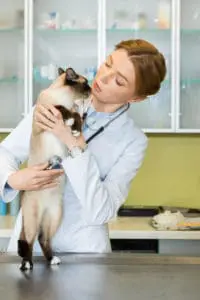
NC State University vets offer treatments
FIC’s elusive causality has rendered it a formidable foe. Traditional approaches have focused on symptom management and stress reduction, with varying degrees of success. However, a pioneering study conducted by the NC State College of Veterinary Medicine is set to revolutionize treatment for this condition.
Dr. Allison Kendall, alongside Dr. Michael Nolan, embarked on an exploratory journey to ascertain the efficacy of low-dose radiation therapy for FIC. This idea was rooted in the known benefits of radiation therapy for treating inflammatory conditions.
The study aimed to provide a novel solution to a disease that often leads to severe outcomes, including euthanasia in approximately 20% of affected cases. The methodology involved treating 15 male cats with low-dose radiation, with promising results.
Almost all participants exhibited significant improvement, with the majority experiencing no further episodes of cystitis. This outcome underscores the potential of radiation therapy as a treatment option and marks a departure from traditional oral medication.
The study’s success is so compelling that NC State Veterinary Hospital will now offer radiation treatments to FIC patients. This development offers hope for pet owners like Danielle Seaman, who witnessed a transformative change in her cat Archer following the treatment.
Further Research is ongoing – this will save LIVES!!
While further research is necessary to refine treatment protocols and expand the therapy’s application to a broader demographic, the initial findings are undeniably promising. Dr. Nolan’s presentation at a national conference has already ignited a wave of interest, with many eager to replicate the treatment in their clinics.
Navigating the complexities of Feline Idiopathic Cystitis demands a deep understanding and a dedicated approach to care. Cat professionals encourage embracing a holistic perspective that includes diet, environment, and medical strategies, cat owners can make significant strides in managing this perplexing condition.
Yet, the journey to optimal pet health doesn’t stop here.
Banixx Cat Care
Stay tuned to Banixx as your go-to source for expert advice, innovative solutions, and compassionate guidance in keeping your cat happy and healthy!
Until then, check out our Cat blog topics “fur fun”! We’ve got many fascinating features on cats – plus other animals like dogs, horses, chickens and goats. Got questions have been plaguing you? “Can my cat turkey for thanksgiving?” “Why does my cat knead?” “What’s with boxes- why is my cat so intrigued?” Come to us for answers!
Sources
https://vcahospitals.com/know-your-pet/feline-idiopathic-cystitis
https://www.petmd.com/cat/conditions/urinary/feline-idiopathic-cystitis-fic-cats
https://veterinarypartner.vin.com/default.aspx?pid=19239&id=4951488
Share this Post
Featured Post
Recent Posts
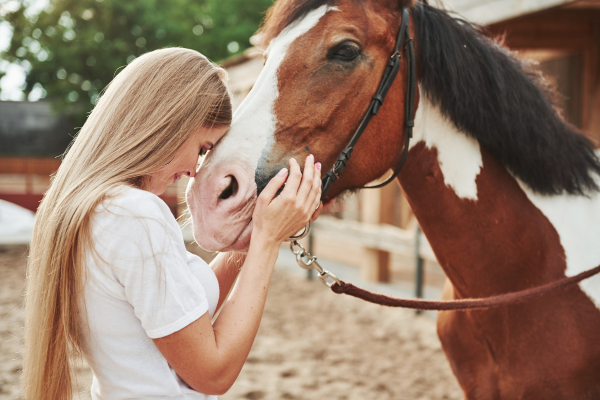
EPM…it’s not The End like it used to be–successful treatments are underway!

Chicken Wound Care: How to Treat an Open Wound on a Chicken?

Oh no! my Dog is Limping…get these useful facts to sort it out!
Why is my Cat peeing everywhere? all the time? All you need to Know about Feline Idiopathic Cystitis

Do horse coat colors affect their behavior?


